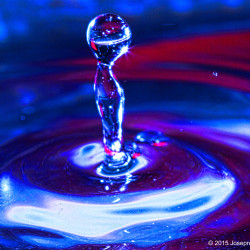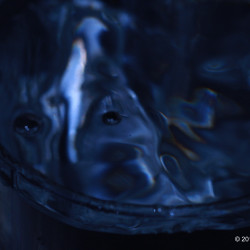
How much drama could there be in falling water droplets? We seem them everyday – in the incessant rain that brings back memories of a wet childhood or right in the kitchen sink amidst the day’s chores. However, when frozen in time with a lens and camera, they reveal marvelous beauty and structure. The droplet pictures here are proof that beauty is all around us. We just have to slow down and look for it.
Well, how to slow down time and freeze it? A high shutter speed could be one way – think of highly paid sports photographers taking exhilarating shots of dazzling F1 cars as they roar past at 200 mph. But thankfully, the simpler way to freeze time is by using the speed of light – with a help of flash! Any flash is perfectly capable of freezing motion. It can be used to capture the asteroid-like impact of droplets hitting a water surface. (The shutter speed doesn’t matter when you are using a flash. See the newbie note at the end of this post). The catch is in the timing. The millisecond moments before, after and during contact with the surface is when nature reveals its beauty. There are expensive equipment out there which can precisely capture those wonderful moments in time. (There are some less expensive ones too – like TriggerTrap, about which I will write about another time). For this lazy afternoon’s photographic experiment, I used the best equipment of all – my own eyes and fingers combined with the timeless process of trial and error.
My location was of the most mundane variety – our kitchen sink, much to the consternation of my wife. I just let the water drip from the goose-neck tap and caught it in a shallow water-filled basin. Adjusting the frequency of the droplets to match the speed of my trigger finger took a few trials. The height between the tap and the basin was another adjustment parameter I played with. After some practice, I was able to time the water droplets almost accurately. In any case, I didn’t have to worry too much if I missed a few milliseconds here or there – the pictures were still incredible! To give the pictures some interesting hues, I also let the water drip into different colored containers.
Now to my equipment setup. To my faithful Canon 7D I attached a 100 mm f2.8 macro lens to get as much details as possible. The flash was ordinary, the Canon Speedlite 320Ex, a simple no-fuss flash that can work as a slave to the in-camera flash of the 7D. I setup the Speedlite off-camera, at an angle, so that it could cover the water basin. I varied the aperture between f11 to f14 to get as much of the ripples as possible and to keep everything in focus. The shutter was at the camera sync speed of 1/250. I mounted the camera on a tripod and auto-focused at the point where the water droplets fell. (I held a spoon at that point to help focus – trying to focus on plain water is not easy). Then I switched to manual focus. If I didn’t the camera would be losing precious milliseconds every time, searching for auto-focus and missing the water droplets altogether.
Once I started clicking, I kept improvising with different containers, different droplet speeds, different apertures, ISO and so on. I also attached a remote trigger to avoid camera shake. The entire setup & shoot took no more than 30 minutes. I did not even plan it. I just kept improvising as the images popped out. With a little bit of planning perhaps I could make better & more artistic pictures – reserved for sometime in the distant future.
I did not do this experiment with the intent of posting it. But when I reviewed the pictures, in my computer, they looked amazing. Well, amazing with a little stretch of the imagination. Other than water droplets, I could see black holes, Oscars and Aphrodite rising from the sea.
Your turn now. Use the comments section to document what else you saw in those pictures.
Newbie note: Why the Shutter doesn’t matter when you are using a flash.
A flash provides an instantaneous burst of light which lasts for around 1/1000 of a second at full power. At reduced power, it would last for even shorter duration. At these immensely small time slices, it fully freezes motion for the sensor to register the picture, much better than what a mechanical shutter-based mechanism could do. Moreover, if the shutter speed is more than the sync speed of the camera, then the flash would illuminate only a portion of the picture. This is a very technical topic. Google for “sync speed” or “flash sync” to get more information and while at it learn how to overcome this limitation using high-speed sync.
- Classic green-man rises above the water surface.
- Demure
- Crater
- A shapely water droplets short life span is about to end.
- Aphrodite Rising
- Oscar
- Starburst with droplets resting on the water fabric.
- Barcoded blackhole gobbling up a globe
- Serenity and texture
- Classic water droplet
- A ghost in a water cup
- A String of Pearls














Captured well!!